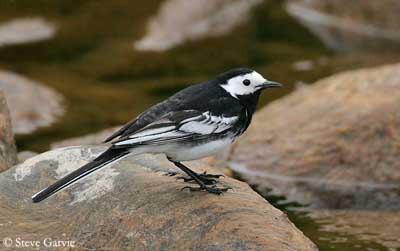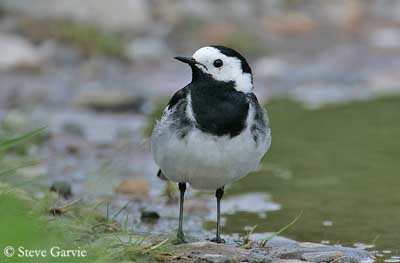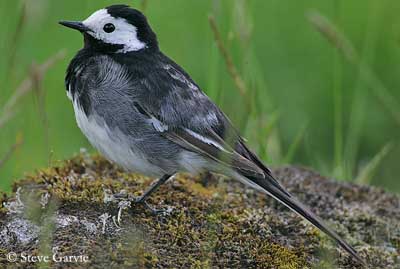
Ang: PiedWagtail
All : Trauer-Bachstelze
Esp : Lavandera de Yarrell
Ital: Ballerina nera
Nd: Rouwkwikstaart
Photographers:
Aurélien Audevard
OUESSANT DIGISCOPING
Steve Garvie
RAINBIRDER Photo galleries
Texte de Nicole Bouglouan
Sources:
HANDBOOK OF THE BIRDS OF THE WORLD Vol 9 - by Josep del Hoyo - Andrew Elliot - David Christie - Lynx Edicions - ISBN: 8487334695
THE HANDBOOK OF BIRD IDENTIFICATION FOR EUROPE AND THE WESTERN PALEARCTIC by Mark Beaman, Steve Madge - C.Helm - ISBN: 0713639601
THE COMPLETE BOOK OF BRITISH BIRDS – Written by “Royal Society for the Protection of Birds” experts - Préface de Magnus Magnusson - Michael Cady- Rob Hume Editors - ISBN: 0749509112
ENCYCLOPEDIE DES OISEAUX DE FRANCE ET D’EUROPE – de Peter Hayman et Rob Hume - Flammarion – ISBN : 2082009920
Wikipedia (Wikipedia, The Free Encyclopedia)
Pied Wagtail
Motacilla (alba) yarrellii
Passeriforme Order – Motacillidae Family
BIOMETRICS:
Length: 16-18 cm
Weight: 17-22 g
DESCRIPTION:
The Pied Wagtail is still classified sometimes as subspecies of the White Wagtail (Motacilla alba), although more often it is now considered as full species with Motacilla yarrellii as scientific name.

The Pied Wagtail is easy to recognize with its bright black, grey and white plumage, and the long swinging tail.
Male has black mantle and black head with white forehead and cheeks.
In breeding plumage, throat and breast are black and flanks rather dark.
During winter, the back is greyer and the throat is white, but we can see a black crescent on the breast. Some yellowish spots can be seen on the face.
The bill is black. Eyes are brown. Legs and feet are black.
Female in breeding plumage has dark slate-grey back and blackish rump. The bib is smaller than in male.
Juvenile is brownish-grey above, with dark double band on the breast. The white parts are washed yellowish, sometimes for the whole winter.
The Pied Wagtail is darker than the White Wagtail (Motacilla alba).
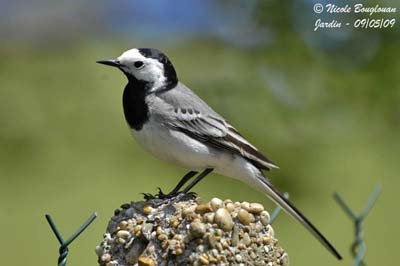
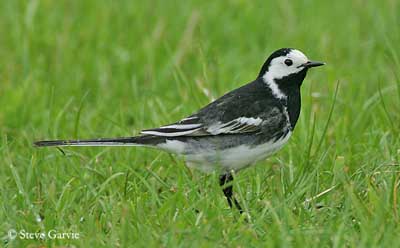
VOICE: SOUNDS BY XENO-CANTO
The Pied Wagtail male is not very vocal. It sings from a perch or close to the nest. We can hear a shrill, clear and happy chirping « tcheeyuu » or « tchiwu », but also a harder « tchess-ek ».
HABITAT:
The Pied Wagtail is found in a wide variety of open areas such as fields, farmlands, parks, grasslands, mainly near water, close to the rocky rivers and in gravel-pits.
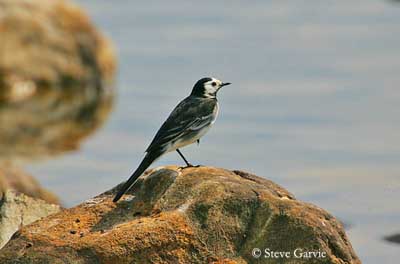
During winter, they gather in trees and buildings.
This species prefers the short grass, but also the roads where it is easy to run. It is relatively common in urban areas and villages.
RANGE:
The Pied Wagtail breeds in Britain and Ireland, and probably in the northern parts of Western Europe.
This species is partially migratory, resident in Britain, but it may winter in northern Scotland. Some parts of the population migrate southwards to France, Spain and even Morocco.
It also performs altitudinal movements, leaving a high area at the beginning of the winter to winter in coasts or towns.
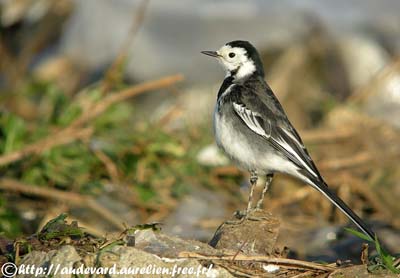
BEHAVIOUR:
The Pied Wagtail is highly territorial in spring, and may attack its own reflexion in a mirror or in the windows of the cars. It usually strongly defends its chicks if they are threatened.
The nest is often parasitized by the Common Cuckoo which mimics the eggs perfectly. The Pied Wagtail keeps the nest very clean and renews some materials regularly.
It feeds by swooping down onto the prey, hovering, running and pursuing insects, its preferred preys. It can be seen near humans, and may damage the gardens by pecking at tomatoes or flowers.
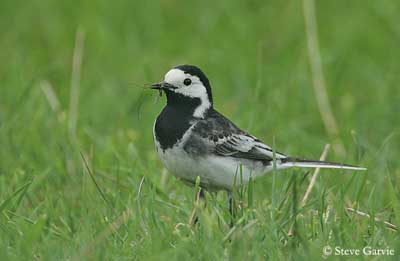
When perched, it often wags the tail up and down.
The wagtails often sleep in communal roosts where they arrive in small groups at dusk. But there are hundreds of birds which gather noisily in trees, before to reach the reed beds, bushes or building ledges to sleep at night.
The Pied Wagtail spends much time on the ground, in open areas, and only reaches the vegetal cover for resting.
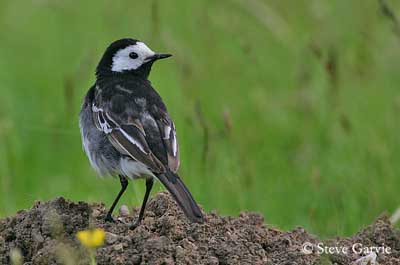
FLIGHT:
The Pied Wagtail performs bounding and undulating flight, with downwards swoops when hunting. It is very agile and may dart rapidly or take off to catch some passing prey.
REPRODUCTION:
The Pied Wagtail nests in hollow, in wall, shed, bank or in ivy. It is made with grass and moss, and lined with feathers or hair.
Female lays 5-6 pale grey spotted eggs. Incubation lasts about 11-13 days. Juveniles fledge about 11-16 days after hatching. They are fed during 3 or 4 weeks more after the first flight.
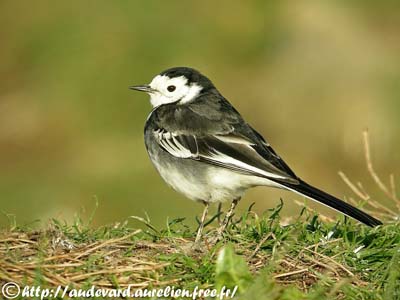
DIET:
The Pied Wagtail feeds on insects, small worms and some seeds.
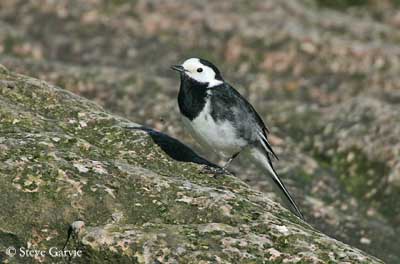
PROTECTION / THREATS / STATUS:
The Pied Wagtail’s populations are declining since 1970s, due to degradation and habitat loss. Fortunately, this species is able to adapt fairly well and we can see large groups perched on supermarket and building roofs built on its former habitat.
Some hybridization occurs between both races alba and yarrellii.
This species is not threatened at this moment.
